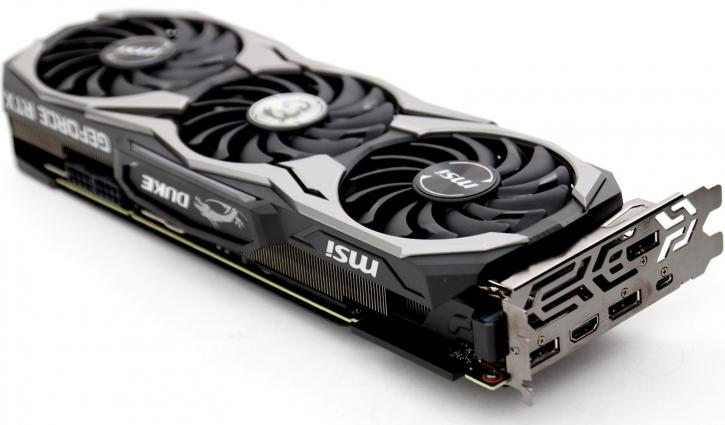Introduction
MSI GeForce RTX 2080 Ti DUKE reviewThe Duke that became a true King
We're now a couple of days away from the official RTX launch, where the RTX 2080 might be the lesser popular product, we do feel that the 2080 Ti series will be the leading product in sales. We now review our second MSI GeForce GX 2080 Ti card, and (if you are willing to spend the cash) this might be the one to get to be totally honest. Meet the DUKE, it's slim, as fast as the TRIO, roughly in the same area cooling and acoustics wise, but it is really, really good you guys. You'll probably notice me being more positive than normal, as this card actually is really sweet.
We've already covered a lot of new technology as the Turing architecture of the new GPUs offers a fundament change in the graphics card arena as next to your normal shading engine, NVIDIA has added RT (Raytracing) cores, as well as Tensor (AI), cores onto the new GPUs, and these are active. Is Turing is the start of the next 20 years of gaming graphics? Well, that all depends on the actual adoption rate in the software houses, they guys and girls that develop games and a dozen or so RTX games are in development and a dozen or so announced titles will make use of deep learning DLSS running utilizing the Tensor cores. For the new RTX series, it's mostly about Raytracing though. So welcome to a long row of RTX reviews. We start off with the reference cards and will follow with the AIB cards as for whatever reason NVIDIA figured it to be an okay thing for them to launch everything at once. First a quick recap of what's tested in this article, a bit of architecture and then we'll dive into real-world testing of course. You better grab a drink as these reference articles are prone to be lengthy with all the information we are covering.
The GeForce RTX 2080 Ti - this is the new consumer flagship graphics card from NVIDIA is the GeForce RTX 2080 Ti, this product series has been fitted with the TU102 GPU. This GPU will have 4352 active shader processors, which is substantial when compared with the GeForce GTX 1080 Ti. The product will get 11GB GDDR6 graphics memory, and with that 11 GB, you will get a 352-bit wide memory bus. The GPU has six Graphics Processing Clusters (GPCs), 36 Texture Processing Clusters (TPCs), and 72 Streaming Multiprocessors (SMs). Each SM contains 64 CUDA Cores, eight Tensor Cores, four texture units, and 96 KB of L1/shared memory which can be configured for various capacities depending on the compute or graphics workloads. Ray tracing acceleration is performed by a new RT Core processing, the TU102 has 72 of them with 576 tensor cores and 96 ROP units. For clock frequencies, we're looking at a 1350 MHz base frequency, with Turbo allowance towards 1635 MHz. Keep some margin in mind for the board partner clock frequencies. The AIB products should start at 999 USD, the founders' edition will start at 1199 USD.
A little story first, a week ago on Thursday the Taiwan product manager flew in to visit us. In an incredibly hectic time frame, we met. The man just landed at Schiphol airport, was picked up, dropped off and drove straight to this meeting. When he arrived, suitcases and all he brought cards for our reviews in these suitcases to speed up getting the products to us. So that said, I first wanted to thanks the MSI team for getting that done, guys that is really nice and so much appreciated.
Prolonging on that story, the PM showed me the two products, he brought me the flagship Gaming X TRIO and the Duke. Immediately when I had my hands on both products I mention to him that the DUKE likely is going to get the more popular product, it just has a much better feel and looks with the two-tone and slim design. So if the cooling and acoustics would be close to what the TRIO is doing, this more affordable version, I figured, is the product that people really are going to prefer.
I just finished testing the DUKE, and my expectations have been confirmed, it's silent at very decent cooling levels. Its weight is nice and simply is a terrific looking and performing product. This puppy is at the very same perf level as the TRIO is. This graphics card comes customized with higher-factory clocks 1665 MHz Boost. That roughly a 100 Mhz lower than the TRIO (1755 MHz Boost) and still it performs the same due to the increases power limiter on both cards. The DUKE also is a triple fan solution with very modest top side RGB lighting. 18 billion transistors or not, this RTX 2080 Ti card is passive up-to roughly 60 Degrees C and has a lot of hidden gems. Neither did it any warmer than 73 Degrees C either. The Gaming X Trio comes with updated looks, it's styled a bit after the Lightning in RGB design elements with a combination that hints towards the Twinfrozr looks. The new cooler is thicker and heavier at 2.7 PCIe slots, but that's definitely worth it as you'll see in our acoustic measurements. The card comes with two 8-pin power headers as well as another 6-pin header, included is a back-plate but also a mounting strut to stabilize the card which MSI previously called "LAN Party Guard", so if you move around the card it'll be secure and tight preventing a sagging card due to movement (as it is heavy). The card offers one HDMI ports and three DisplayPort outputs and the new Virtual link (USB) connector. This Turing 102 GPU empowered product keeps that GPU at that 73 Degrees C marker depending on game load. The GDDR6 memory has been not been tweaked, the new Micron ICs are a stock 14 GHz (effective clock-rate) but it was bumped towards 16 GHz with the flick of my fingers. Have a quick peek above and then dive into the full review.


